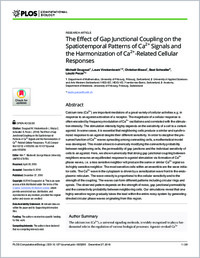The effect of gap junctional coupling on the spatiotemporal patterns of Ca2+ signals and the harmonization of Ca2+-related cellular responses
- Dougoud, Michaël Department of Mathematics, University of Fribourg, Switzerland
- Vinckenbosch, Laura Department of Mathematics, University of Fribourg, Switzerland - University of Applied Sciences and Arts Western Switzerland // HES-SO, HEIG-VD, Yverdon-les-Bains, Switzerland
- Mazza, Christian Department of Mathematics, University of Fribourg, Switzerland
- Schwaller, Beat Anatomy, Department of Medicine, University of Fribourg, Switzerland
- Pecze, László Anatomy, Department of Medicine, University of Fribourg, Switzerland
-
27.12.2016
Published in:
- PLOS Computational Biology. - 2016, vol. 12, no. 12, p. e1005295
English
The calcium ion (Ca²⁺), a universal signaling molecule, is widely recognized to play a fundamental role in the regulation of various biological processes. Agonist–evoked Ca²⁺ signals often manifest as rhythmic changes in the cytosolic free Ca²⁺ concentration (ccyt) called Ca²⁺ oscillations. Stimuli intensity was found to be proportional to the oscillation frequency and the evoked down-steam cellular response. Stochastic receptor expression in individual cells in a cell population inevitably leads to individually different oscillation frequencies and individually different Ca²⁺-related cellular responses. However, in many organs, the neighboring cells have to overcome their individually different sensitivity and produce a synchronized response. Gap junctions are integral membrane structures that enable the direct cytoplasmic exchange of Ca²⁺ ions and InsP₃ molecules between neighboring cells. By simulations, we were able to demonstrate how the strength of intercellular gap junctional coupling in relation to stimulus intensity can modify the spatiotemporal patterns of Ca²⁺ signals and harmonize the Ca²⁺-related cellular responses via synchronization of oscillation frequency. We demonstrate that the most sensitive cells are the wave initiator cells and that a highly sensitive region plays an important role in the determination of the Ca²⁺ phase wave direction. This sensitive region will then also progressively determine the global behavior of the entire system.
- Faculty
- Faculté des sciences et de médecine
- Department
- Département de Mathématiques, Département de Médecine
- Language
-
- English
- Classification
- Biological sciences
- License
-
License undefined
- Identifiers
-
- RERO DOC 288679
- DOI 10.1371/journal.pcbi.1005295
- Persistent URL
- https://folia.unifr.ch/unifr/documents/305425
Statistics
Document views: 83
File downloads:
- pdf: 145
